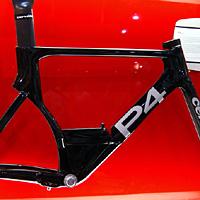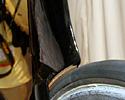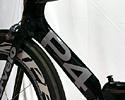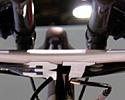

|

|
 |

|

|

|

|
 |
 |

|
 |
 |
 |
Interbike show
Las Vegas, Nevada, USA, September 22-26, 2008
Main Page Previous Part Next Part
Part 5 - September 25: Road rigs from the lights and glitter of Las Vegas
By James Huang in Las Vegas, Nevada
Cervélo debuts eagerly anticipated P4

|
Cervélo unveiled its long awaited P4 time trial/triathlon frame to much fanfare during the first indoor day of this year’s Interbike trade show. As the successor to the highly popular (and competitively successful) P3C, Cervélo understandably set out to create something that was not only more aerodynamic but also better - or at least comparable – in terms of overall rigidity, drivetrain efficiency, weight and rider comfort.
Cervélo took a much more integrated approach to the P4 than the P3C which was essentially an aero frame with a bunch of other parts bolted on. The fork is now a custom Cervélo design that blends in well with the head tube and dropped down tube, thus forming a more continuous surface for less interrupted airflow. Spacing between the tire and crown and legs has supposedly also been optimized in the wind tunnel.
Further up the head tube, custom aero-profiled headset spacers mesh perfectly with the 3T Ventus bar that was on the display bike and as on the recently launched S3 road frame, the internally routed housings for the rear brake and derailleurs enter into the top of the top tube behind the stem. The result is an ultra-clean front end that, at least on inspection, should provide a clean leading edge to the wind.
Just above the bottom bracket is perhaps one of the most interesting aspects of the new P4: an integrated water bottle. When snapped into its proprietary built-in holder, the bottle not only offers 570ml of fluid but also cleans up the aerodynamics in the area by virtue of the newly continuous surface area. In fact, Cervélo claims the P4 is faster with the bottle attached than without.
A handy flip-top lid allows on-the-go refilling, too, and an optional utility box will take the bottle’s place for those who want a place to stash inflator cartridges, tools and the like. Another alternative will be a 'structural stiffener’.

|
The P4’s rear brake is mounted aft of the bottom bracket but instead of placing it either above or below the chain stays, Cervélo houses a proprietary integrated unit directly inside the frame. The tiny cantilever brake comprises over a dozen individual pieces yet is claimed to be 30 percent lighter than a Dura-Ace caliper. More importantly, Cervélo also claims the integrated rear brake provides comparable power and modulation when coupled with the structural carbon booster plate which, conveniently, also acts as the outer cover. The cover is easily removable when brake adjustments are needed.
Even without these integrated touches, the P4 frame shape is more slippery than its forebear. The bigger asymmetrical chain stays are more rigid than before and also more aerodynamic, especially in crosswinds. The slender aero-shaped seat stays now join the deeply scalloped seat tube further down than before, too, in order to present less frontal area. Naturally, all of the rest of the tubes use aero profiles.
Though official weights weren’t available at the time of introduction, we anticipate the new P4 to be no more than the P3C’s roughly 1300g for a bare 54cm sample. Framesets will begin shipping around December of this year and will fetch US$4,800; complete bikes with SRAM Red will arrive shortly thereafter for US$6,800.
Storck flies the 'lighter, stiffer and more comfortable’ flag for Germany

|
German frame builders are renowned for their ability to create exceptionally light frames that are also fantastically stiff and Storck’s top-end Fascenario line has been widely heralded by a number of third-party objective testers as being among the lightest and stiffest out there.
According to company founder Marcus Storck, a big part of the secret is his new VVC (Vacuum Void Control) manufacturing process. Rather than just use internally applied pressure to distribute resin and compact the tube walls from the inside out during the molding process, Storck also adds an autoclave to suck the resin through the fibers.
Storck claims the process yields more consistent resin penetration and fewer voids, thus producing the expected jump in tube stiffness (a remarkable 30-40 percent, says Storck) and increased durability. Surprisingly though, the resultant tube is also more resilient and supposedly makes the Fascenario more comfortable, too.

|
While the technology is impressive, it’s also expensive: the Fascenario 0.7 frameset alone is over US$6,000. Storck aims to bring its technology a little more down to earth with the Fenomalist, though, which is a relative bargain at US$3,800 for the frame, fork and headset. Complete bikes with Dura-Ace 7900, Mavic Ksyrium SL Premium wheels and an array of Syntace components will go for US$7,999.
The Fenomalist trades in the Fascenario’s VCC process for more conventional bladder-molded construction and claimed frame weight jumps to 991g as a result; the included carbon fork adds another 400g. While almost 300g heavier than the Fascenario, the Fenomalist is still no heavyweight and stiffness figures are apparently even better in some instances.
How is it on the road? We don’t know yet but will find out soon: our test bike is slated to arrive sometime in October. Check back in a few weeks.
Photography
For a thumbnail gallery of these images, click here
Images by Cervélo
- Cervélo officially unveiled its stunning new P4 during the first indoor day of the Interbike trade show.
- Naturally, aero tube profiles are used throughout.
- Interestingly, the frame bears a giant 'P4' logo on the down tube instead of the usual Cervélo badge.
- The internally routed cables feed into the housing stops accessed through the little port in the down tube.
- A flip-top lid on the water bottle makes for easy on-the-go refilling.
- The tube surfaces around the bottom bracket are extra clean since the brake is housed within.
- Cervélo couldn’t leave the unused saddle clamp hole empty, right?
- Moving the rear brake down to the bottom bracket obviously afforded Cervélo much more freedom in shaping this area.
- The driveside dropout isn't easily replaceable but at least it looks rather sturdy.
- The asymmetrical chain stays are absolutely enormous.
- The rear of the fork crown blends in well with the down tube.
Images by James Huang/Cyclingnews.com
- The new P4 is definitely more of an integrated chassis than its P3C forebear.
- The dropped down tube helps smooth airflow coming off of the front wheel.
- Custom headset spacers mate perfectly with the bottom of the 3T Ventus stem.
- Internally routed cables on the Ventus bar also help clean up the front end.
- The frontal profile is rather clean.
- Zipp says the new P4 is substantially faster than the P3C.
- An integrated bottle smooths airflow around the bottom bracket area.
- Cervélo says the P4 is faster with the bottle installed than without.
- The giant asymmetrical chain stays stiffen up the rear end.
- Even with their girth, Cervélo says the new chain stays are more aero than before.
- The rear triangle is particularly clean. But hey, where's the rear brake?
- With no brake mounted up top, the slim seat stays are free to sprout cleanly off the sides of the frame.
- We're guessing air flows neatly off the rear edge of this area.
- The rear brake is a custom Cervélo design and is housed entirely within the chain stays. The little gold knob is the quick release.
- Aluminum dropouts incorporate threaded adjusters.
- The aero post offers two offsets…
- …and the neat wedge-style clamp means there's no protruding clamps.
- The new P4 is decidedly sleeker looking than the P3C.
- A purpose-built fork replaces the rather standard unit on other Cervélo aero frames.
- The deep seat tube cutout shields the rear wheel.
- The P4 intro was expectedly met with much fanfare.
- Storck's Fascenario 0.7 is reputedly one of the lightest and stiffest bikes out there.
- Storck aims to deliver most of the Fascenario's performance in a less expensive package with its new Fenomalist.
- The Fenomalist basically uses the same rear triangle as the Fascenario but the front triangle of an Absolutist.
- The Storck fork isn't particularly light but is expected to be rather stiff.
- Big fat chain stays grace the rear end.
- The top tube and down tube are both flattened on their lower surfaces to improve rigidity.
- Even the housing stops are well done.